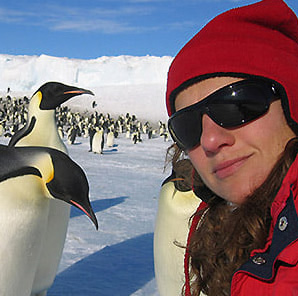|
Two Polar "Alumni", Both Women, Serving Aboard the International Space Station 
National Science Foundation Posted September 27, 2019 Jessica Meir, formerly an NSF funded, U.S. Antarctic Program researcher and now a NASA - National Aeronautics and Space Administration astronaut, joined the crew of the International Space Station (ISS) earlier this week, temporarily increasing the orbiting laboratory's population to nine people, one of whom is fellow astronaut Christina Hammock Koch, who also served in the Antarctic Program and at NSF’s Summit Station in Greenland (Gronland). Koch—who also worked at NSF's Palmer and Amundsen-Scott South Pole stations in Antarctica—has served on ISS expeditions 59, 60 and now 61. She is slated to set a record for the longest single spaceflight by a woman, with an expected total of 328 days in space: https://www.nasa.gov/astronauts/biographies/christina-h-koch According to NASA, Expedition 61 crew will spend more than six months conducting research in fields such as biology, Earth science, physical sciences, and technology development. Later in the mission, spacewalkers will install new lithium-ion batteries for two of the station’s solar arrays. Spacewalkers are scheduled to upgrade and repair the Alpha Magnetic Spectrometer. Read more in a NASA news release here: https://www.nasa.gov/press-release/nasa-astronaut-jessica-meir-crewmates-arrive-safely-at-international-space-station In Antarctica, Meir worked with researcher Paul Ponganis, of the Scripps Institution of Oceanography at the University of California, San Diego, her doctoral-dissertation adviser, to study the physiology of some of the world’s accomplished diving animals: Antarctic emperor penguins and elephant seals. Emperors can dive for almost 30 minutes on a single breath, and the record dive of a northern elephant seal is almost two hours. The research may provide clues about adaptations in these animals that could benefit humans in the future. For example, tolerance to hypoxia--low levels of oxygen in the blood stream--has implications for better methods of harvesting and preserving organs for transplant, and treatment of heart-attack and stroke victims. Read more, in a 2009 NSF “Discovery”, here: https://www.nsf.gov/discoveries/disc_summ.jsp?org=NSF&cntn_id=115268 With NSF support, Meir later studied physiological adaptations of bar-headed geese and how they manage to migrate over the Himalaya--conquering the cold, wind and low-oxygen conditions of the mountains--while travelling between their winter feeding grounds in southern Asia and their summer breeding grounds in the Central Asian Highlands. Read more here: https://www.nsf.gov/discoveries/disc_summ.jsp?cntn_id=118659
|



For USAP Participants |
For The Public |
For Researchers and EducatorsContact UsNational Science FoundationOffice of Polar Programs Geosciences Directorate 2415 Eisenhower Avenue, Suite W7100 Alexandria, VA 22314 Sign up for the NSF Office of Polar Programs newsletter and events. Feedback Form |

